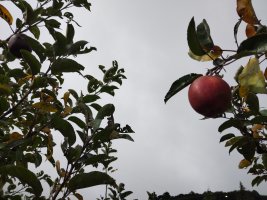ciderguymex
New Member
Goodnight. Being 10:40 p.m., on a cold night in the deep mountains of Mexico, a group of enthusiasts are very interested in rescuing a method of making Mexican artisanal cider that came from France in the 19th century according to our sources and this is where I enter, in this great problem.
Years ago, our team had the opportunity to win a national beer award and given that great precedent, (beginner's luck, haha), I agreed to collaborate with friends who seek to rescue the famous local cider that you can no longer find anywhere despite that everyone in this beautiful town has apple orchards (and very rich)
Not to bore you anymore, I'm having trouble understanding how to sweeten barrel cider with a cheap fermentable sugar, but because of the time and costs, plus we don't have enough infrastructure, I'm going to force carbonation because time is killing me.
My biggest fear is having a Tsar bomb in a 30 liter barrel on hand.
I have 25 gallons, 12.5 of a local variety of yellow apple with pink highlights very rich and sweet and another 12.5 of a beautiful red apple with purple highlights very interesting. All the fruit here is organic and without pesticides or anything similar.
With this, too many questions arise but I will try to synthesize them and I will thank you with all my heart if you can give me advice.
The first is: How true and safe is it that by cooling the cider in the barrel I can use a fermentable sugar to soften its dryness a bit without so much risk of carbonated more? (I am going to carbonate this cider in a forced way)
2. Do those fermentable sugars to make a Back-sweetened have to be incorporated when the cider is already cold before carbonating and having a slow and inactive yeast?
3. Can I mix the method of campden tablets + sulphites + cider cooling at low temperatures to further reduce the risk of overcarbonation?
I know that keeping the cider cold, it is difficult for it to carbonate due to the sugars that were incorporated through a "back-sweetened" but I do want to know what level of risk we have in case, one night, we run out of energy or some electrical accident or anything that could increase the ideal temperature for the yeast a little or a lot.
Here where I am, at the moment it is not cheap to buy xylitol or erythritol due to the distance from the nearest city and we also considered sticking to the resources we have.
Brothers and sisters cider makers. I will be sharing with all of you our great adventure through these distant and very rich lands. The people are very beautiful and the food is extremely special and enjoyable.
Thank you very much for reading and I hope to return the favor for the help.
He writes to you with love, his friend, Ciderguymex.
I give you some visual material
Years ago, our team had the opportunity to win a national beer award and given that great precedent, (beginner's luck, haha), I agreed to collaborate with friends who seek to rescue the famous local cider that you can no longer find anywhere despite that everyone in this beautiful town has apple orchards (and very rich)
Not to bore you anymore, I'm having trouble understanding how to sweeten barrel cider with a cheap fermentable sugar, but because of the time and costs, plus we don't have enough infrastructure, I'm going to force carbonation because time is killing me.
My biggest fear is having a Tsar bomb in a 30 liter barrel on hand.
I have 25 gallons, 12.5 of a local variety of yellow apple with pink highlights very rich and sweet and another 12.5 of a beautiful red apple with purple highlights very interesting. All the fruit here is organic and without pesticides or anything similar.
With this, too many questions arise but I will try to synthesize them and I will thank you with all my heart if you can give me advice.
The first is: How true and safe is it that by cooling the cider in the barrel I can use a fermentable sugar to soften its dryness a bit without so much risk of carbonated more? (I am going to carbonate this cider in a forced way)
2. Do those fermentable sugars to make a Back-sweetened have to be incorporated when the cider is already cold before carbonating and having a slow and inactive yeast?
3. Can I mix the method of campden tablets + sulphites + cider cooling at low temperatures to further reduce the risk of overcarbonation?
I know that keeping the cider cold, it is difficult for it to carbonate due to the sugars that were incorporated through a "back-sweetened" but I do want to know what level of risk we have in case, one night, we run out of energy or some electrical accident or anything that could increase the ideal temperature for the yeast a little or a lot.
Here where I am, at the moment it is not cheap to buy xylitol or erythritol due to the distance from the nearest city and we also considered sticking to the resources we have.
Brothers and sisters cider makers. I will be sharing with all of you our great adventure through these distant and very rich lands. The people are very beautiful and the food is extremely special and enjoyable.
Thank you very much for reading and I hope to return the favor for the help.
He writes to you with love, his friend, Ciderguymex.
I give you some visual material





